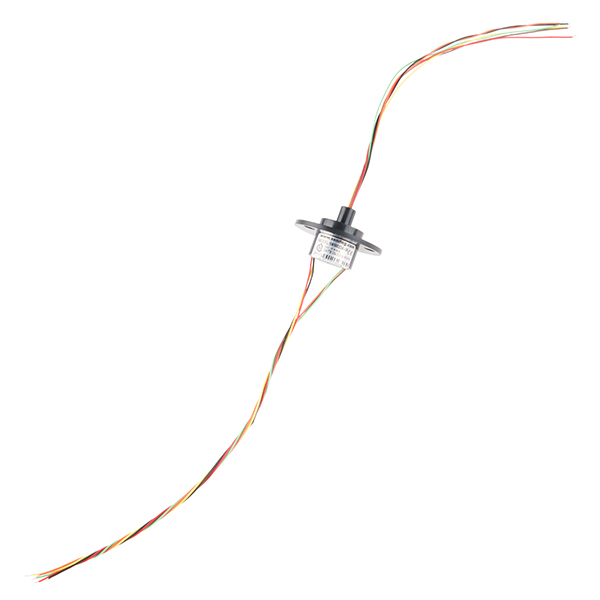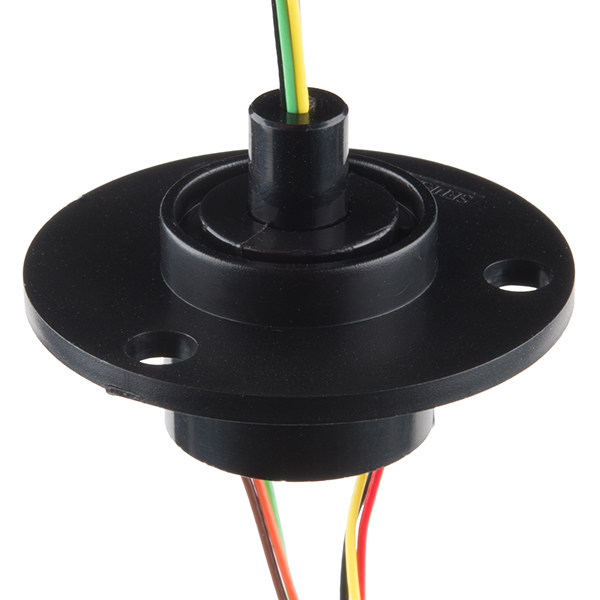This is a 6 wire slip ring, a remarkably simple electromechanical assembly that allows electronic signals to be passed through its rotating innards. Commonly, you'd find slip rings in wind turbines, radar antennae, or anything else that requires continuous 360° rotation while maintaining an electrical connection. This particular slip ring provides you with a compact body with gold-on-gold alloy fiber brush to plated ring contacts inside.
Each Slip ring is capable of handling a continuous working speed of 250RPM, a current rating of 2A, and an operating voltage of 210VDC / 240VAC. We aren't kidding about how compact this little guy is, with only and outer diameter of 22mm for the body an 44.5mm diameter flange, you should have no issues fitting these into your next project. Additionally, the 250mm stranded wires protruding from each side of the slip ring have a thickness of 28AWG while the whole assembly has a water protection rating of IP51.
- 6 wires
- Voltage: 210VDC / 240VAC
- Current Rating: 2A
- Operating Speed: 250RPM
- Compatible with data bus protocols
- Transfers analog and digital signals
- 22mm Diameter x 19.5mm Length w/ 44.5mm Diameter Flange
Slip Ring - 6 Wire (2A) Product Help and Resources
**Slip Ring in continuous rotation camera**
For whose who have seen the video, and want to recreate Nick's camera rig, here is the parts list, and how they're attached. The full rig
ROB-12433 screws onto the camera mount with a bolt and washer
2x ROB-13139 1/2" standoff for USB BOB
ROB-12505 holds camera and USB BOB
2x ROB-131391/2" standoff under plate, all attached to
ROB-12209, the pulley, on
ROB-12414 clamped onto a 2" long, 1" diameter tube going through
ROB-12282, the bearing block.
ROB-13064, the slip ring fits inside the tube, with the narrow end going into
ROB-12214, which attaches to
ROB-12122, the base
ROB-12282, the bearing block mentioned before, attaches to
ROB-12287 with washers, then to
4xROB-12247 standoffs, on
ROB-12122, the base
ROB-12209, the large pulley from before connects with
ROB-12116, the smooth belt, to
ROB-12523, the hub mount pulley, which mounts on ROB-12347, the servo kit, which mounts on ROB-09347, the servo. 4x ROB-12286, standoffs attach the servo kit to ROB-12122, the base
All held together with machine screws in two lengths as needed, ROB-12525 ROB-12485
Reference Photos
Core Skill: Robotics
This skill concerns mechanical and robotics knowledge. You may need to know how mechanical parts interact, how motors work, or how to use motor drivers and controllers.
Skill Level: Noob - You will be required to put together a robotics kit. Necessary parts are included and steps will be easy to follow. You also might encounter basic robotics components like bearings, mounts, or other hardware and need a general idea of how it goes together.
See all skill levels
Core Skill: Electrical Prototyping
If it requires power, you need to know how much, what all the pins do, and how to hook it up. You may need to reference datasheets, schematics, and know the ins and outs of electronics.
Skill Level: Competent - You will be required to reference a datasheet or schematic to know how to use a component. Your knowledge of a datasheet will only require basic features like power requirements, pinouts, or communications type. Also, you may need a power supply that?s greater than 12V or more than 1A worth of current.
See all skill levels
Comments
Looking for answers to technical questions?
We welcome your comments and suggestions below. However, if you are looking for solutions to technical questions please see our Technical Assistance page.
Customer Reviews
4 out of 5
Based on 2 ratings:
6 of 6 found this helpful:
Works well, but mind the specs.
I've created a 1m RGB POV display based on LPD8806 LED strips, and this slip ring. It worked great for development, and probably lasted a month of evening dev time, or 100-200 hours. No problem handing high data rates. But I was running it out of spec at 300-420 rpm. I knew I was taking a chance but wanted to push it to the limits. I installed it in it's home for 3 months, and the slip ring failed soon after. When it fails with the LPD8806 you'll see a Stanley Kubrick-esque radial display of chaos. It actually looks really cool to those who don't understand, but it indicates that the clock and data lines have an intermittent connection as the slip ring turns.
Long story short, I recommend this for within spec projects that stay under 250 RPM and do not have huge duty cycle requirements. Beyond that you should look at industrial-strength replacements like those from mercotac or similar. Look closely at the max RPM specs, and duty cycle if available. A duty cycle or lifetime spec for this product would be helpful. 250 RPM might be useful if your POV has 3-4 arms and therefore needs less RPM than a dual-arm.
Excellent device
Works perfectly and solves the very difficult problem of getting power and signals to a rotating platform




Is it feasible to use this slip ring to measure degrees of rotation disc?
Is there anyway to get these with a 4 bolt pattern to match the 0.770" hub pattern from Actobotics?
Please get more of these in stock and please get the flange less version too. I bought one from a competitor and it took a week to get here. It also was $13 shipping UPS ground. Which is ridiculous. I came here first before buying but nothing was in stock. I was going to get this version and chop off the flange.